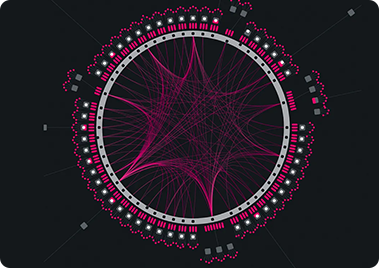Polkadot is a sharded multi-chain network that is a hub for numerous blockchains. It is a mega blockchain hosting multiple blockchains on itself.
Currently, there are two ways blockchains operate — A single blockchain specializing in only one thing or a ‘do it all blockchain’ that could do it all. However, neither seems to be a way forward in building a decentralized world. Independent specialized blockchains lack interoperability, and the ‘do it all’ lacks customization and scalability.
Specialized blockchains find it hard to communicate with other blockchains and share data. For instance, if a finance blockchain had to speak with an identity management blockchain, it’s tough to do it in a trustless manner. The ‘do it all’ blockchain, on the other hand, is a one-size fit-all network stuffed with all the possible features to host all kinds of applications, thus lacking customization and scalability. Every use case utilizes different features, and all features may not be important for multiple use cases on the blockchain. Since it hosts a large variety of applications, it is likely to face network congestion.
Polkadot meets somewhere in between, where it is a ‘do it all’ blockchain and a ‘specialized blockchain’ at the same time. The network hosts multiple specialized blockchains called parachains and connects them to a single network called the relay chain.
A Guide to the Polkadot Blockchain — The What, Why and How
Polkadot is the blockchain of blockchains. It is fair that Web 3.0 began with the launch of blockchain technology, but the true Web 3.0 revolution will begin as these advancements get adopted into real life. Bitcoin and Ethereum have played a significant role in the early stage of Web 3.0, but as we move past that, we will need something like Polkadot. Polkadot is a multi-chain blockchain network that connects different specialized blockchains into a single network.
It makes blockchain technology more applicable to the real world by overcoming the challenges with existing blockchains.
Why Do We Need Polkadot?
The decentralized blockchain technology is remarkable; it irons out many issues around centralized data storing and ownership. However, this technology has not become mainstream yet, and Polkadot can help accelerate its mainstream adoption.
Six ways in which Polkadot outperforms legacy blockchains are :
1. Interoperability
Before Polkadot, every blockchain was like a separate planet that had nothing to do with other planets in the universe. But operating in a world like that isn’t easy because they need to interact with each other to offer a decentralized ecosystem of services to users.
For example, if a financial services blockchain had to share data with an identity management blockchain, they could not do it in a trustless manner. But in a decentralized world, a user would want to be able to share data across blockchains.
Polkadot being a hub of multiple blockchains called parachains, can easily avoid this. Parachains are independent blockchains built on top of Polkadot. They can easily interact with each other and share data. Parachains can also communicate with different blockchains outside their ecosystem using bridges. This is called interoperability. Interoperability makes blockchains more real-world applicable as no one blockchain can do everything.
2. One size fits all
Blockchains need to make trade-offs to support different features and use cases. For example, one chain might optimize for dapp development while one chain can optimize for payments. It allows the creation of specialized blockchains that can do one thing really well.
Parachains are fully customizable blockchains; they are not one size fits all. Each parachain can have its unique design, token economy, functionality and governance.
For instance, the Ethereum blockchain is used to build all kinds of applications from DeFi to NFT to Gaming. But all of its characteristics might not be relevant for all of its use cases. On Polkadot, you can create specialized blockchains for each use case and customize them based on the requirements.
3. Scalability
Traditional blockchains are highly resilient but painfully slow. For instance, the transaction speed of Bitcoin is max 7tps while for Ethereum, it is 25tps. This is because single blockchains can only process a limited amount of traffic. But because Polkadot is a sharded multi-chain network, it can process many transactions parallelly, thus improving the speed.
For example, on an Ethereum blockchain, all kinds of transactions from DeFi to NFT’s to Gaming will be in the queue to get processed. While on Polkadot, the transactions are spread out on multiple parallel chains.
Additionally, because of network congestion, these networks are super expensive. At a point in 2018, one Bitcoin transaction cost around $37 and currently, it is over $150. Ethereum is also facing scalability issues because of which the applications on the network are slowing down. All of these issues could be resolved using Polkadot.
4. Security
Legendary blockchains like Bitcoin and Ethereum are highly secure, but other newer blockchains like Ethereum Classic, Bitcoin Gold etc., are vulnerable to security breaches. Chains that are secured by their own security need to maintain a secure amount of hash power on their networks, failing which large mining cartels may attack them. Thus it is challenging to build a robust blockchain.
This is one of the reasons most dapps are built on Ethereum instead of a new blockchain of its own. But as discussed earlier, Ethereum is a one size fits all blockchain, plus it lacks scalability.
So if one has to build a dapp, they will either have to choose customization over security or vice versa. However, with Polkadot, nothing needs to be compromised. You can have a fully customized blockchain that is also highly secure. How? The parachains on Polkadot share the security of the entire network. They are all connected to a relay chain and derive security from relay chain validators rather than bootstrapping their own independent network of miners.
5. Governance
The traditional blockchains lack the ability to determine the road map of the blockchain on-chain. So usually, the decision making is very centralized, with one man controlling the activity or developers taking calls for the community.
While on the other hand, Polkadot ensures that all DOT token holders have a say in its governance. The token holders can register themselves to become a part of the Polkadot Council and represent stakeholders and submit proposals etc.
The parachain teams can customize their blockchains governance to their needs and have a say in the future of the entire Polkadot network as a whole.
6. Upgrades
Blockchains need timely upgrades to stay relevant. But often, these upgrades lead to hard forks, splitting the blockchain into two. Hardfork creates two independent blockchains that can’t talk to each other, what happens then is either the old blockchain becomes redundant, and the people using that drop it or the new one gives up. Forking splits the community.
Whereas Polkadot enables forkless on-chain upgrades, any upgrade on the network does not lead to a fork.
How does Polkadot work
The relay chain is the heart of Polkadot; it’s the main blockchain of the network to which all other blockchains are connected. Primarily relay chain is responsible for providing cross-chain interoperability and communication to both internal and external blockchains. It also maintains network security and consensus protocol.
The relay chain has minimum functionality so that it can focus on its primary objective of enabling interoperability. For example, smart contracts are not supported via the Relay Chain; instead, they are implemented through Substrate, Polkadot’s dedicated framework to expedite blockchain creation and developments on parachains.
Parachains are independent blockchains connected to the relay chain that process transactions at lightning speed through parallel processing. These chains lease the relay chain slot for connectivity and pay as they go. Parachains can even host their own coins and optimize for specific use cases and control governance.
Another important part of the Polkadot architecture is the Bridges. Bridges are used to help the Polkadot network connect with external blockchains like Ethereum. A great example of a bridge is the Kusama network.






